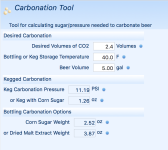I have been brewing for more than 25 years, but I haven't bottled a beer in over a decade. I just decided to do so. I opened up the carbonation tool and used 2.5 ounces of dextrose. Well, looking at my recipe later I see it calls for 5 ounces. Imagine my disappointment that my entire batch will be under carbonated.
So, the 40 degree default means what? Serving temp is all that's useful, so I'm rather confused by the keg or bottle storage temperature. If for some reason it is supposed to be the conditioning temp then 40 degrees is a terrible default (all but the heartiest of lager yeasts are dormant at 40 degrees).
Please advise. I think this tool could use an update.
So, the 40 degree default means what? Serving temp is all that's useful, so I'm rather confused by the keg or bottle storage temperature. If for some reason it is supposed to be the conditioning temp then 40 degrees is a terrible default (all but the heartiest of lager yeasts are dormant at 40 degrees).
Please advise. I think this tool could use an update.

